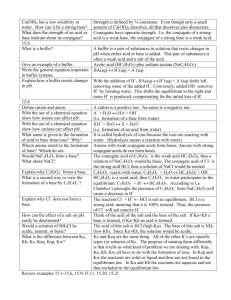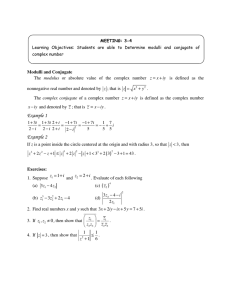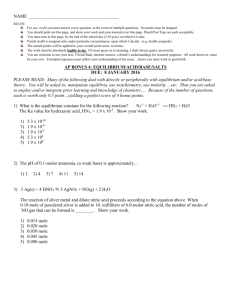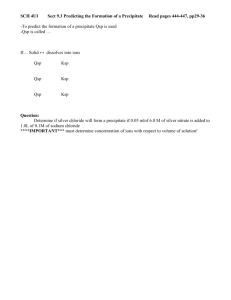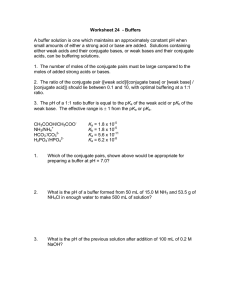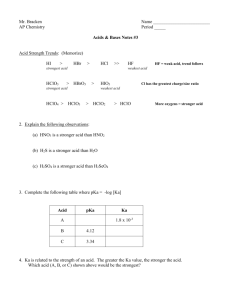Ca(OH) has a low dissolves,
advertisement
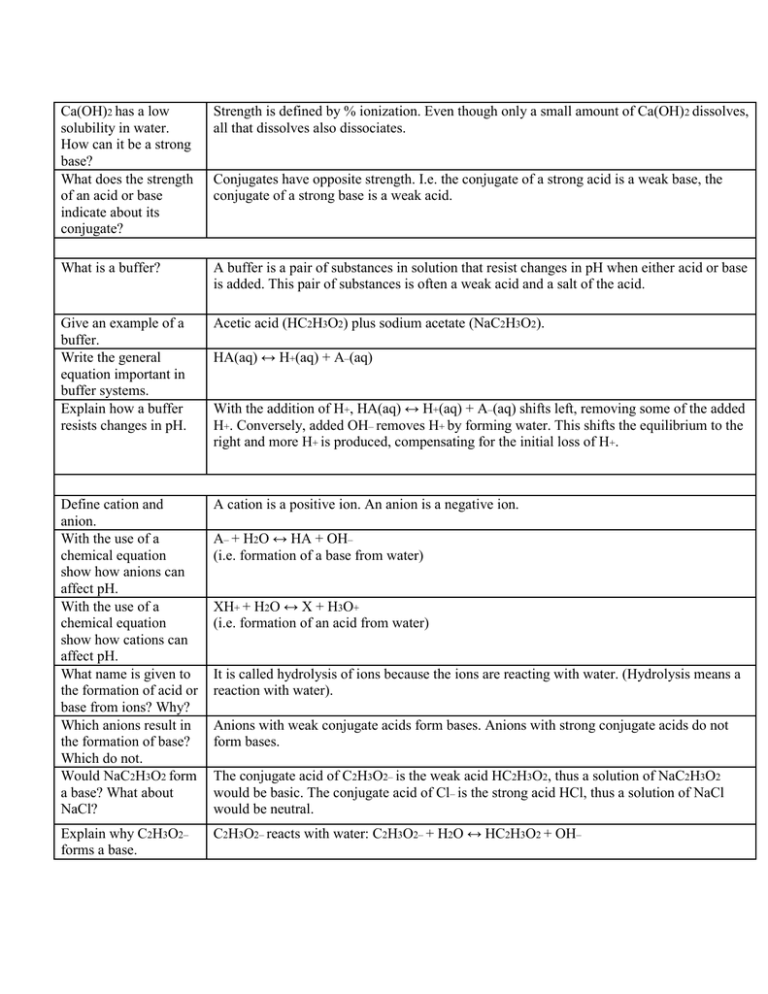
Ca(OH)2 has a low solubility in water. How can it be a strong base? What does the strength of an acid or base indicate about its conjugate? Strength is defined by % ionization. Even though only a small amount of Ca(OH) 2 dissolves, all that dissolves also dissociates. What is a buffer? A buffer is a pair of substances in solution that resist changes in pH when either acid or base is added. This pair of substances is often a weak acid and a salt of the acid. Give an example of a buffer. Write the general equation important in buffer systems. Explain how a buffer resists changes in pH. Acetic acid (HC2H3O2) plus sodium acetate (NaC2H3O2). Define cation and anion. With the use of a chemical equation show how anions can affect pH. With the use of a chemical equation show how cations can affect pH. What name is given to the formation of acid or base from ions? Why? Which anions result in the formation of base? Which do not. Would NaC2H3O2 form a base? What about NaCl? A cation is a positive ion. An anion is a negative ion. Explain why C2H3O2– forms a base. C2H3O2– reacts with water: C2H3O2– + H2O ↔ HC2H3O2 + OH– Conjugates have opposite strength. I.e. the conjugate of a strong acid is a weak base, the conjugate of a strong base is a weak acid. HA(aq) ↔ H+(aq) + A–(aq) With the addition of H+, HA(aq) ↔ H+(aq) + A–(aq) shifts left, removing some of the added H+. Conversely, added OH– removes H+ by forming water. This shifts the equilibrium to the right and more H+ is produced, compensating for the initial loss of H+. A– + H2O ↔ HA + OH– (i.e. formation of a base from water) XH+ + H2O ↔ X + H3O+ (i.e. formation of an acid from water) It is called hydrolysis of ions because the ions are reacting with water. (Hydrolysis means a reaction with water). Anions with weak conjugate acids form bases. Anions with strong conjugate acids do not form bases. The conjugate acid of C2H3O2– is the weak acid HC2H3O2, thus a solution of NaC2H3O2 would be basic. The conjugate acid of Cl– is the strong acid HCl, thus a solution of NaCl would be neutral. What is a second way to view the formation of a base by C2H3O2–? HC2H3O2 is a weak acid, thus C2H3O2– in water participates in the equilibrium: C2H3O2– + H+ ↔ HC2H3O2. According to Le Chatelier’s principle the presence of C2H3O2– from NaC2H3O2 will cause a decrease in H+. Explain why Cl– does not form a base. The reaction Cl– + H+ ← HCl is not an equilibrium. HCl is a strong acid, meaning that it is 100% ionized. Thus, the presence of Cl– will not remove H+. How can the effect of a salt on pH easily be determined? Would a solution of NH4Cl be acidic, neutral, or basic? What is the difference between Ka, Kb, Kc, Keq, Ksp, Kw? Think of the acid of the salt and the base of the salt. If Ka<Kb a base is formed, if Ka>Kb an acid is formed. The acid of this salt is HCl (high Ka). The base of this salt is NH3 (low Kb). Since Ka>Kb, the solution would be acidic. Kc and Keq are the same thing. All of the other K’s are specific types (or subsets) of Kc. The purpose of naming them differently is that it tells us what kind of problem we are dealing with. Ksp, Ka, Kb, Kw all have to do with the formation of ions. In Ksp and Kw the reactants are solid or liquid and thus are not found in the equilibrium law. In Ka and Kb the reactants are aqueous and are thus included in the equilibrium law.
